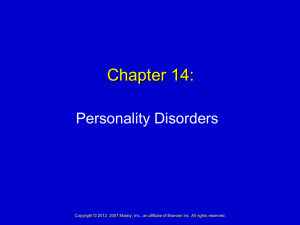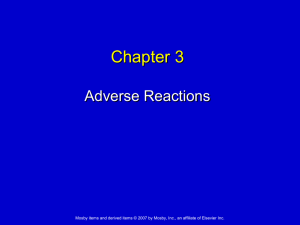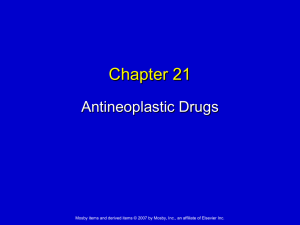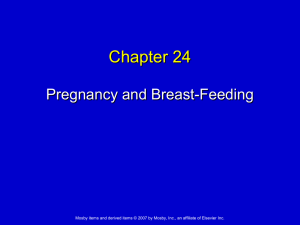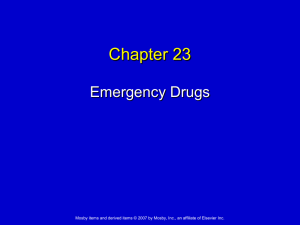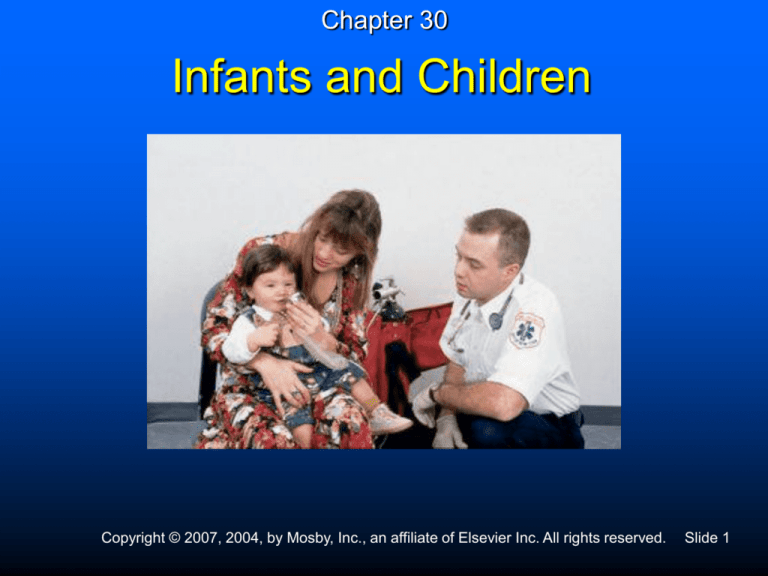
Chapter 30
Infants and Children
Copyright © 2007, 2004, by Mosby, Inc., an affiliate of Elsevier Inc. All rights reserved.
Slide 1
Case History
You respond to a child in respiratory distress. On
arrival, you observe a 3-year-old boy experiencing
difficulty breathing with a “barking” cough, stridor, and
active accessory muscle use. Your initial assessment
reveals hot and dry skin, cyanosis, “seesaw”
breathing, and retractions between the ribs. The
mother advises you that the child awoke from sleep
30 minutes ago. The symptoms have become
progressively worse.
Copyright © 2007, 2004, by Mosby, Inc., an affiliate of Elsevier Inc. All rights reserved.
Slide 2
Spiral of Pediatric Arrest
Copyright © 2007, 2004, by Mosby, Inc., an affiliate of Elsevier Inc. All rights reserved.
Slide 3
Newborns and Infants –
Birth to 1 Year of Age
Minimal stranger anxiety
Do not like to be separated from parents
Do not want to be suffocated by an oxygen mask
Need to be kept warm
Make sure hands and stethoscope are warmed before touching
child.
Breathing rate best obtained at a distance
Examine heart and lungs first, head last.
Copyright © 2007, 2004, by Mosby, Inc., an affiliate of Elsevier Inc. All rights reserved.
Slide 4
Toddlers – 1 to 3 Years
Do not like to be touched
Do not like being separated from parents
Do not like having clothing removed
Remove, examine, replace
May feel suffocated by an oxygen mask
Copyright © 2007, 2004, by Mosby, Inc., an affiliate of Elsevier Inc. All rights reserved.
Slide 5
Toddlers – 1 to 3 Years
Children think their illness/injury is punishment
Reassure child that he or she was not bad.
Afraid of needles and fear of pain
Provide encouragement but be honest.
If possible, keep child close to parent.
Head-to-toe approach
Copyright © 2007, 2004, by Mosby, Inc., an affiliate of Elsevier Inc. All rights reserved.
Slide 6
Preschoolers – 3 to 6 Years
Do not like to be touched
Do not like being separated from parents
Do not like having clothing removed
Remove, examine, replace
Do not want to be suffocated by an oxygen mask
Copyright © 2007, 2004, by Mosby, Inc., an affiliate of Elsevier Inc. All rights reserved.
Slide 7
Preschoolers – 3 to 6 Years
Children think that the illness/injury is a punishment
Reassure child that he or she was not bad.
Afraid of blood and fear of pain
Fear of permanent injury
Modest
Copyright © 2007, 2004, by Mosby, Inc., an affiliate of Elsevier Inc. All rights reserved.
Slide 8
School Age – 6 to 12 Years
Afraid of blood
Fear of pain and permanent injury
Fear of disfigurement/permanent injury
Modest
Should be treated as adults.
May desire to be assessed privately, away from parents or
guardians
Copyright © 2007, 2004, by Mosby, Inc., an affiliate of Elsevier Inc. All rights reserved.
Slide 9
Adolescents – 12 to 18 Years
Fear of disfigurement/permanent injury
Modest
Should be treated as adults.
May desire to be assessed privately, away from parents or
guardians
Copyright © 2007, 2004, by Mosby, Inc., an affiliate of Elsevier Inc. All rights reserved. Slide 10
Anatomic and Physiologic Concerns –
Airway
Small airways throughout the respiratory system
Easily blocked by secretions and airway swelling
Tongue is large relative to small mandible.
Positioning
Can block airway in an unconscious infant or child
Do not hyperextend the neck
Infants are obligate nose breathers.
Suctioning nasopharynx can improve breathing.
Copyright © 2007, 2004, by Mosby, Inc., an affiliate of Elsevier Inc. All rights reserved. Slide 11
Comparison of Airway Anatomy
Copyright © 2007, 2004, by Mosby, Inc., an affiliate of Elsevier Inc. All rights reserved. Slide 12
Suctioning
Vacuum
Child – 300 mm Hg
Newborn – 100 mm Hg
Technique
Child – large-bore, rigid catheter
Newborn and infant – soft catheter or bulb syringe
Copyright © 2007, 2004, by Mosby, Inc., an affiliate of Elsevier Inc. All rights reserved. Slide 13
Oral Airways
Used for patients who do not have a gag reflex
Insert directly using tongue blade.
Take care to avoid injury to soft tissues.
Copyright © 2007, 2004, by Mosby, Inc., an affiliate of Elsevier Inc. All rights reserved. Slide 14
Sizing
Multiple sizes
Sizing technique
Corner of the lips to
bottom of earlobe
Copyright © 2007, 2004, by Mosby, Inc., an affiliate of Elsevier Inc. All rights reserved. Slide 15
Breathing
Respiratory rate higher than
adults
Interventions
Humidified oxygen
Keep patient warm
If PPV necessary, do not
overinflate; watch for gastric
inflation.
Copyright © 2007, 2004, by Mosby, Inc., an affiliate of Elsevier Inc. All rights reserved. Slide 16
Compensatory Ability
Children can compensate well for short periods of
time.
Increased breathing rate
Increased effort of breathing
Compensation is followed rapidly by
decompensation.
Rapid respiratory muscle fatigue
General fatigue of the infant
Copyright © 2007, 2004, by Mosby, Inc., an affiliate of Elsevier Inc. All rights reserved. Slide 17
Circulation – Pulse Rate
Copyright © 2007, 2004, by Mosby, Inc., an affiliate of Elsevier Inc. All rights reserved. Slide 18
Circulation – Blood Pressure
Blood pressure increases with age.
Use appropriate size BP cuff.
Use formula to determine lower limit for systolic BP
70 + (2 x Age in years)
Systolic BP <70 mm Hg with tachycardia and cool skin are
indicators of shock.
Copyright © 2007, 2004, by Mosby, Inc., an affiliate of Elsevier Inc. All rights reserved. Slide 19
Circulation – Bleeding and Shock
Hypovolemic – most common shock found in children
Bleeding
Dehydration
Copyright © 2007, 2004, by Mosby, Inc., an affiliate of Elsevier Inc. All rights reserved. Slide 20
Dehydration in Children
Copyright © 2007, 2004, by Mosby, Inc., an affiliate of Elsevier Inc. All rights reserved. Slide 21
Blood or Fluid Loss
Average blood volume – 80 ml/kg
Children can maintain BP until almost 40% of fluid
volume is lost.
Low BP is a LATE sign of shock.
Copyright © 2007, 2004, by Mosby, Inc., an affiliate of Elsevier Inc. All rights reserved. Slide 22
Shock – Causes
Rarely a primary cardiac event
Common causes
Diarrhea and dehydration
Trauma
Vomiting
Blood loss
Infection
Abdominal injuries
Copyright © 2007, 2004, by Mosby, Inc., an affiliate of Elsevier Inc. All rights reserved. Slide 23
Shock – Causes
Less common
Allergic reactions
Poisoning
Cardiac
Copyright © 2007, 2004, by Mosby, Inc., an affiliate of Elsevier Inc. All rights reserved. Slide 24
Signs and Symptoms –
Shock
Rapid respiratory rate
Pale, cool, clammy skin
Weak or absent peripheral pulses
Delayed capillary refill
Copyright © 2007, 2004, by Mosby, Inc., an affiliate of Elsevier Inc. All rights reserved. Slide 25
Signs and Symptoms –
Shock
Decreased urine output
Ask parents about diaper wetting and look at diaper.
Mental status changes
Absence of tears, even when crying
Copyright © 2007, 2004, by Mosby, Inc., an affiliate of Elsevier Inc. All rights reserved. Slide 26
Metabolic Considerations
Keep child warm.
Higher baseline metabolic rate
• Growing requires more fuel than adults.
• Rapid respiratory and pulse rates
Need to expend more energy to keep warm.
Infants <6 months do not have ability to shiver.
Copyright © 2007, 2004, by Mosby, Inc., an affiliate of Elsevier Inc. All rights reserved. Slide 27
General Impression
Assessment of mental status
Effort of breathing
Color
Quality of cry/speech
Copyright © 2007, 2004, by Mosby, Inc., an affiliate of Elsevier Inc. All rights reserved. Slide 28
Interaction with
Environment and Parents
Normal behavior for child of this age
Playing
Moving around
Attentive versus nonattentive
Eye contact
Recognizes parents
Responds to parent’s calling
Response to the EMT
Should be appropriately upset
Tone/body position
Copyright © 2007, 2004, by Mosby, Inc., an affiliate of Elsevier Inc. All rights reserved. Slide 29
Approach to Evaluation
Begin from across the room.
Mechanism of injury
Assessment of surroundings
General impression of well versus sick
Copyright © 2007, 2004, by Mosby, Inc., an affiliate of Elsevier Inc. All rights reserved. Slide 30
Assess Breath Sounds
Present
Absent
Stridor
Wheezing
Cyanosis
Copyright © 2007, 2004, by Mosby, Inc., an affiliate of Elsevier Inc. All rights reserved. Slide 31
Detailed Physical Exam
Begin with a trunk-to-head approach.
Situation- and age-dependent
Should help reduce the infant or child’s anxiety
Copyright © 2007, 2004, by Mosby, Inc., an affiliate of Elsevier Inc. All rights reserved. Slide 32
Common Problems
in Infants and Children
Airway obstructions
Respiratory emergencies
Seizures
Altered mental status
Poisonings
Fever
Shock
Near drowning
SIDS
Copyright © 2007, 2004, by Mosby, Inc., an affiliate of Elsevier Inc. All rights reserved. Slide 33
Airway Obstruction –
Croup
Copyright © 2007, 2004, by Mosby, Inc., an affiliate of Elsevier Inc. All rights reserved. Slide 34
Airway Obstruction –
Epiglottitis
Copyright © 2007, 2004, by Mosby, Inc., an affiliate of Elsevier Inc. All rights reserved. Slide 35
Mild –
Infant or Child Alert and Sitting
Stridor, crowing, or noisy
Retractions on inspiration
Pink
Good peripheral perfusion
Still alert, not unconscious
Copyright © 2007, 2004, by Mosby, Inc., an affiliate of Elsevier Inc. All rights reserved. Slide 36
Emergency Medical Care
Allow position of comfort.
Assist younger child to sit up.
Do not lay the child down; may sit on parent’s lap.
Offer oxygen and transport.
Do not agitate child, limited examination.
Do not assess blood pressure.
Copyright © 2007, 2004, by Mosby, Inc., an affiliate of Elsevier Inc. All rights reserved. Slide 37
Foreign Body Airway Obstruction
(FBAO)
Determine
LOC
Air exchange
Ability to speak or cry
History of respiratory infections, fever, barking cough
History of choking
Treat all suspected infectious causes of obstruction as if they
are epiglottitis.
Copyright © 2007, 2004, by Mosby, Inc., an affiliate of Elsevier Inc. All rights reserved. Slide 38
FBAO – The Alert Child
Keep management to a minimum.
Keep parents and child calm.
Allow position of comfort (parent’s arms).
Administer humidified oxygen if child will allow (without
agitation).
Transport without delay.
Do not intervene if child is alert and moving air.
Copyright © 2007, 2004, by Mosby, Inc., an affiliate of Elsevier Inc. All rights reserved. Slide 39
FBAO – Severe
Unconscious
Reopen airway/reattempt ventilation (PPV).
If child has a foreign body obstruction, perform CPR.
When you open the airway look for a FB.
» If you see it, remove it with a finger sweep.
Copyright © 2007, 2004, by Mosby, Inc., an affiliate of Elsevier Inc. All rights reserved. Slide 40
Airway Obstruction Management
Infant
Back blows
Chest thrusts
Child
Abdominal thrusts
Copyright © 2007, 2004, by Mosby, Inc., an affiliate of Elsevier Inc. All rights reserved. Slide 41
Respiratory Emergencies
Recognize the difference between upper airway
obstruction and lower airway disease.
Upper airway obstruction
Stridor on inspiration
Lower airway disease
Wheezing
Breathing effort on exhalation
Rapid breathing (tachypnea) without stridor
Copyright © 2007, 2004, by Mosby, Inc., an affiliate of Elsevier Inc. All rights reserved. Slide 42
Early Respiratory Distress
Nasal flaring
Intercostal retraction
Neck muscles, supraclavicular, subcostal retractions
Stridor
Neck and abdominal muscle retractions
Audible wheezing
Grunting
Copyright © 2007, 2004, by Mosby, Inc., an affiliate of Elsevier Inc. All rights reserved. Slide 43
Severe Respiratory Distress
Early signs, plus
Altered mental status
Rate >60/min
Cyanosis
Decreased muscle tone
Severe use of accessory muscles
Poor peripheral perfusion
Altered mental status
Grunting
Copyright © 2007, 2004, by Mosby, Inc., an affiliate of Elsevier Inc. All rights reserved. Slide 44
Respiratory Arrest
Breathing rate <10/min
Limp muscle tone
Unconscious
Slower, absent heart rate
Weak or absent distal pulses
Copyright © 2007, 2004, by Mosby, Inc., an affiliate of Elsevier Inc. All rights reserved. Slide 45
Emergency Medical Care
Provide oxygen for all respiratory distress.
Assist ventilation for severe respiratory distress.
Respiratory distress and altered mental status
Presence of cyanosis with oxygen
Respiratory distress with poor muscle tone
Respiratory failure
Provide oxygen and ventilate with bag-valve-mask for
respiratory arrest.
Copyright © 2007, 2004, by Mosby, Inc., an affiliate of Elsevier Inc. All rights reserved. Slide 46
Submersion Incident/
Near Drowning
Artificial ventilation is top priority.
Consider possibility of trauma.
Consider possibility of hypothermia.
Consider possible ingestion, especially alcohol.
Copyright © 2007, 2004, by Mosby, Inc., an affiliate of Elsevier Inc. All rights reserved. Slide 47
Submersion Incident/
Near Drowning
Protect airway, suction if necessary.
Secondary drowning syndrome
Deterioration after breathing is normal from minutes to hours
after event.
All near submersion incident victims should be transported to
the hospital.
Copyright © 2007, 2004, by Mosby, Inc., an affiliate of Elsevier Inc. All rights reserved. Slide 48
Emergency Medical Care
Ensure airway and provide oxygen.
Be prepared to artificially ventilate.
Manage bleeding, if present.
Elevate legs.
Keep warm.
Transport.
Note need for rapid transport of infant and child
Secondary examination is completed en route
Copyright © 2007, 2004, by Mosby, Inc., an affiliate of Elsevier Inc. All rights reserved. Slide 49
Sudden Infant Death Syndrome
(SIDS)
Sudden death of infants in first year of life
Causes are many and not clearly understood.
Baby is most commonly discovered in the early
morning.
Copyright © 2007, 2004, by Mosby, Inc., an affiliate of Elsevier Inc. All rights reserved. Slide 50
Emergency Medical Care
Try to resuscitate,unless rigor mortis present.
Parents will be in agony from emotional distress,
remorse, and imagined guilt.
Avoid any comments that might suggest blame to the
parents.
Copyright © 2007, 2004, by Mosby, Inc., an affiliate of Elsevier Inc. All rights reserved. Slide 51
Fever
Common reason for infant or child ambulance call
Many causes
Rarely life-threatening
Severe cause — meningitis
Fever with a rash is a potentially serious consideration.
Emergency medical care
Transport.
Be alert for seizures.
Copyright © 2007, 2004, by Mosby, Inc., an affiliate of Elsevier Inc. All rights reserved. Slide 52
Seizures
Seizures in children are rarely life threatening.
Seizures may be brief or prolonged.
Assess for presence of injuries.
Causes
Fever and infections
Poisoning
Hypoglycemia
Trauma
Decreased levels of oxygen
Idiopathic in children
Copyright © 2007, 2004, by Mosby, Inc., an affiliate of Elsevier Inc. All rights reserved. Slide 53
Seizures – History
Has the child had prior seizure(s)?
If yes, is this the child’s normal seizure pattern?
Has the child taken his or her prescribed anti-seizure
medications?
Copyright © 2007, 2004, by Mosby, Inc., an affiliate of Elsevier Inc. All rights reserved. Slide 54
Emergency Medical Care
Ensure airway position and patency.
Position patient on side, if no possibility of cervical
spine trauma.
Have suction ready.
Copyright © 2007, 2004, by Mosby, Inc., an affiliate of Elsevier Inc. All rights reserved. Slide 55
Emergency Medical Care
Provide oxygen.
Respiratory arrest or severe respiratory distress
Ensure airway position and patency.
Ventilate with bag-valve-mask
Transport
Although brief seizures are not harmful, a more dangerous
underlying condition may exist.
Copyright © 2007, 2004, by Mosby, Inc., an affiliate of Elsevier Inc. All rights reserved. Slide 56
Head Injury and Seizures
Seizures can be caused by head injury.
Inadequate breathing and/or altered mental status
may occur after a seizure.
Copyright © 2007, 2004, by Mosby, Inc., an affiliate of Elsevier Inc. All rights reserved. Slide 57
Altered Mental Status –
Causes
Hypoglycemia
Poisoning
Postseizure
Infection
Head trauma
Decreased oxygen levels
Hypoperfusion (shock)
Copyright © 2007, 2004, by Mosby, Inc., an affiliate of Elsevier Inc. All rights reserved. Slide 58
Emergency Medical Care
Ensure patency of airway.
Be prepared to artificially ventilate/suction.
Transport.
Copyright © 2007, 2004, by Mosby, Inc., an affiliate of Elsevier Inc. All rights reserved. Slide 59
Poisonings
Poisoning is a common reason for infant and child
EMS calls.
Identify suspected container through adequate
history.
Bring container to receiving facility, if possible.
Copyright © 2007, 2004, by Mosby, Inc., an affiliate of Elsevier Inc. All rights reserved. Slide 60
Emergency Medical Care –
Responsive Patient
Contact medical control.
Consider need to administer activated charcoal.
Provide oxygen.
Transport.
Continue to monitor patient.
May become unresponsive
Copyright © 2007, 2004, by Mosby, Inc., an affiliate of Elsevier Inc. All rights reserved. Slide 61
Emergency Medical Care –
Unresponsive Patient
Ensure patency of airway.
Be prepared to artificially ventilate.
Provide oxygen, if indicated.
Call medical direction.
Transport.
Rule out trauma.
Trauma can cause altered mental status.
Copyright © 2007, 2004, by Mosby, Inc., an affiliate of Elsevier Inc. All rights reserved. Slide 62
Trauma
Motor vehicle passengers
Struck while riding bicycle
Pedestrian struck by vehicle
Falls from height
Diving into shallow water
Burns
Sports injuries of head and neck
Child abuse
Copyright © 2007, 2004, by Mosby, Inc., an affiliate of Elsevier Inc. All rights reserved. Slide 63
Head Injury
Open airway
Modified jaw thrust
Head injury with internal injuries is likely in children.
Signs and symptoms of shock with head injury
Suspicion of other possible injuries
Respiratory arrest
Common secondary to head injuries
May occur during transport
Copyright © 2007, 2004, by Mosby, Inc., an affiliate of Elsevier Inc. All rights reserved. Slide 64
Head Injury
Common signs and symptoms are nausea and
vomiting.
Most common cause of hypoxia is tongue obstructing
the airway.
Jaw thrust is critically important.
Do not use sandbags.
Copyright © 2007, 2004, by Mosby, Inc., an affiliate of Elsevier Inc. All rights reserved. Slide 65
Chest Injury
Children have very soft, pliable ribs.
Significant injuries may be present without external
signs.
Copyright © 2007, 2004, by Mosby, Inc., an affiliate of Elsevier Inc. All rights reserved. Slide 66
Abdomen and Extremities
More common site of injury in children than adults
Often a source of hidden injury
Always consider abdominal injury in the multiple trauma patient
with no external signs whose condition is deteriorating.
Air in stomach can distend abdomen.
Interferes with artificial ventilation efforts.
Extremities
Injuries are managed in the same manner as adults.
Copyright © 2007, 2004, by Mosby, Inc., an affiliate of Elsevier Inc. All rights reserved. Slide 67
Other Trauma Considerations
Pneumatic antishock garments can be used for children.
Use only if PASG fits child.
Do not place infant in one leg of trouser
Indications for PASG use
Trauma with signs of severe hypoperfusion and pelvic instability
Do not inflate abdominal compartment.
Criticality of burns
Cover with sterile dressing (nonstick).
Identify candidates for burn centers.
Copyright © 2007, 2004, by Mosby, Inc., an affiliate of Elsevier Inc. All rights reserved. Slide 68
Emergency Medical Care
Ensure airway position and patency.
Use jaw thrust.
Suction as necessary.
Provide oxygen.
Assist ventilations as needed.
Provide spinal immobilization.
Transport immediately.
Copyright © 2007, 2004, by Mosby, Inc., an affiliate of Elsevier Inc. All rights reserved. Slide 69
Child Abuse and Neglect
Definition of abuse
Definition of neglect
Improper or excessive action so as to injure or cause harm
Giving insufficient attention or respect to someone who has a claim
to that attention
EMT must be aware of condition to be able to recognize the
problem.
Copyright © 2007, 2004, by Mosby, Inc., an affiliate of Elsevier Inc. All rights reserved. Slide 70
Signs and Symptoms –
Abuse
Multiple bruises in various stages of healing
Injury inconsistent with mechanism described.
Repeated calls to the same address.
Fresh burns
Parents are inappropriately unconcerned.
Conflicting stories
Child fearful to discuss how the injury occurred.
Copyright © 2007, 2004, by Mosby, Inc., an affiliate of Elsevier Inc. All rights reserved. Slide 71
Abuse –
Belt Marks
Copyright © 2007, 2004, by Mosby, Inc., an affiliate of Elsevier Inc. All rights reserved. Slide 72
Abuse –
Bruises on Four Surfaces
Copyright © 2007, 2004, by Mosby, Inc., an affiliate of Elsevier Inc. All rights reserved. Slide 73
Abuse –
Immersion Scald
Copyright © 2007, 2004, by Mosby, Inc., an affiliate of Elsevier Inc. All rights reserved. Slide 74
Appearance of Bruises in Various
States of Healing
Age of Bruise
1-3 days
3-7 days
>7 days
>3 weeks
Appearance
Red/blue
Purple
Yellow/brown
Brown to clearing
Copyright © 2007, 2004, by Mosby, Inc., an affiliate of Elsevier Inc. All rights reserved. Slide 75
Signs and Symptoms –
Neglect
Lack of adult supervision
Malnourished-appearing child
Unsafe living environment
Untreated chronic illness
CNS injuries are the most lethal.
Shaken baby syndrome
Copyright © 2007, 2004, by Mosby, Inc., an affiliate of Elsevier Inc. All rights reserved. Slide 76
Reporting Abuse
Do not accuse in the field.
Accusation and confrontation delays transportation.
Bring objective information to the receiving facility.
Reporting required by state law and local regulations.
Be objective.
Document what you see and what you hear, NOT what you think.
Copyright © 2007, 2004, by Mosby, Inc., an affiliate of Elsevier Inc. All rights reserved. Slide 77
Infants and Children
with Special Needs
Premature babies with lung disease
Babies and children with heart disease
Infants and children with neurologic disease
Children with chronic disease or altered function from birth
Often these children will be at home, technologically dependent.
Copyright © 2007, 2004, by Mosby, Inc., an affiliate of Elsevier Inc. All rights reserved. Slide 78
Tracheostomy Tubes
Copyright © 2007, 2004, by Mosby, Inc., an affiliate of Elsevier Inc. All rights reserved. Slide 79
Suction of Tracheostomy
Copyright © 2007, 2004, by Mosby, Inc., an affiliate of Elsevier Inc. All rights reserved. Slide 80
Gastrostomy Tube
Copyright © 2007, 2004, by Mosby, Inc., an affiliate of Elsevier Inc. All rights reserved. Slide 81
Central Lines
Intravenous lines (IVs) placed near the heart for long-term use
Complications
Cracked line
Infection
Clotting off
Bleeding
Emergency medical care
If bleeding, apply pressure.
Transport.
Copyright © 2007, 2004, by Mosby, Inc., an affiliate of Elsevier Inc. All rights reserved. Slide 82
Shunts
Device running from brain to abdomen to drain excess cerebrospinal
fluid
Reservoir on side of skull
Change in mental status
Prone to respiratory arrest
Manage airway.
Ensure adequate ventilation.
Transport
Copyright © 2007, 2004, by Mosby, Inc., an affiliate of Elsevier Inc. All rights reserved. Slide 83
Family Response
A child cannot be cared for in isolation from the family.
You have multiple patients.
Strive for calm.
Calm parents = calm child
Agitated parents = agitated child
Anxiety arises from concern over child’s pain; fear for child’s
well-being.
Anxiety is worsened by sense of helplessness.
Copyright © 2007, 2004, by Mosby, Inc., an affiliate of Elsevier Inc. All rights reserved. Slide 84
Family Response
Parent may respond to EMT with anger or hysteria.
Parents should remain part of the care unless child is not aware
or medical conditions require separation.
Parents should be instructed to calm child; can maintain position
of comfort and/or hold oxygen.
Parents may not have medical training, but they are experts on
what is normal or abnormal for their children and what will have
a calming effect.
Copyright © 2007, 2004, by Mosby, Inc., an affiliate of Elsevier Inc. All rights reserved. Slide 85
Provider Response
Anxiety from lack of experience with seriously injured
children
Fear of failure
Skills can be learned and applied to children.
Identifying patient with his or her own children
Copyright © 2007, 2004, by Mosby, Inc., an affiliate of Elsevier Inc. All rights reserved. Slide 86
Provider Response
Providers should
Realize that much of what they learned about adults applies
to children
Remember the differences
Infrequent encounters with sick children
Advance preparation is important.
Copyright © 2007, 2004, by Mosby, Inc., an affiliate of Elsevier Inc. All rights reserved. Slide 87

